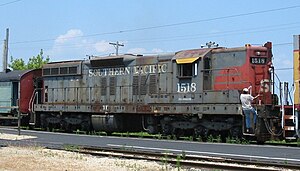EMD SD series

The EMD SD series , English EMD SD-unit or SD-series, is a series of six-axle diesel locomotives from the US locomotive manufacturer General Motors Electro-Motive Division (EMD).
development
The machines of the EMD F-series are said to have ushered in the end of steam train operations on freight trains in North America . However, these machines were only partially suitable for local freight traffic with its extensive shunting maneuvers . The main points of criticism, in addition to the restricted view to the rear, were the lack of shunting steps and the frontal arrangement of the controls in the driver's cab . With the development of the GP series EMD had indeed suitable both for line service and shunting series developed, but that was axle of four-axle models GP7 for some railway lines simply too high. As a solution, EMD offered a six-axis version of the GP series.
construction
The first vehicles of the SD7 series were F7 , similar to the four-axle sister series GP7 in terms of mechanical equipment . In contrast to the machines of the E and F series , which were equipped with self-supporting bodies , the SD received hoods that are easier to maintain. Until then, this design was mainly used for shunting locomotives. However, the SD7 received a gear ratio for higher speeds. This meant that the machines could also be used on the route. The mechanical equipment, such as the diesel engine , generator and auxiliary equipment, were housed in the long hood behind the driver's cab. A steam generator for train heating could be accommodated in the short part of the hood in front of the driver's cab . This meant that the machines could be used in passenger train services . However, this facility was not installed on all machines. A dynamic brake could also be installed at the customer's request . The machines that had this equipment could easily be identified by the additional fans in the middle of the long hood.
The first machines were equipped with the EMD 567 engine series already used in the E and F series. The successor series EMD 645 was used later. All machines were two three-axle bogies of wheel arrangement fitted Co 'Co'. Each of the six axles was powered. Due to the longer bogies, the frames of the machines had to be extended accordingly.
EMD designated this locomotive series as the SD series, whereby SD stands for special duty.
Series
| Type | from | to | number of pieces | power | engine |
|---|---|---|---|---|---|
| SD7 | 1952 | 1953 | 188 | 1,500 hp = 1,100 kW | EMD 16-567B |
| SD9 | 1954 | 1959 | 515 | 1,750 hp = 1,300 kW | EMD 16-567C |
| SD18 | 1960 | 1963 | 114 | 1,800 hp = 1,340 kW | EMD 16-567D1 |
| SD24 | 1958 | 1963 | 224 | 2,250 hp = 1,675 kW | EMD 16-567D3 |
| SD28 | 1965 | 1965 | 12 | 1,800 hp = 1,340 kW | EMD 16-567D1 |
| SD35 | 1964 | 1966 | 360 | 2,500 hp = 1,860 kW | EMD 16-567D3A |
| SD38 | 1967 | 1971 | 53 | 2,000 hp = 1,490 kW | EMD 645E |
| SD38-2 | 1972 | 1979 | 83 | 2,000 hp = 1,490 kW | EMD 16-645E3 |
| SD39 | 1968 | 1970 | 54 | 2,300 hp = 1,700 kW | EMD 12-645E3 |
| SD40 | 1966 | 1972 | 1268 | 3,000 hp = 2,200 kW | EMD 16-645E3 |
| SD40-2 | 1972 | 1986 | 3,949 | 3,000 hp = 2,200 kW | EMD 16-645E3 |
| SD45 | 1965 | 1971 | 1,260 | 3,600 hp = 2,650 kW | EMD 20-645E3 |
| SD45-2 | 1972 | 1974 | 136 | 3,600 hp = 2,650 kW | EMD 20-645E3 |
| SD50 | 1984 | 1985 | 421 | 3,600 hp = 2,650 kW | EMD 16-645F3B |
| SD60 | 1984 | 1991 | 537 | 3,800 hp = 2,830 kW | EMD 16-710G3A |
| SD70 | 1992 | 1994 | 122 | 4,000 hp = 2,940 kW | EMD 16-710G3 |
| SD70M | 1994 | 2004 | 1,646 | 4,000 hp = 2,940 kW | EMD 16-710G3 |
| SD70MAC | 1993 | 2004 | 1.109 | 4,000 hp = 2,940 kW | EMD 16-710G3 |
| SD80MAC | 1995 | 1996 | 30th | 5,000 hp = 3,725 kW | EMD 20-710G3B-ES |
| SD9043MAC | 1996 | 1999 | 370 | 4,300 hp = 3,160 kW | EMD 16-710G3B |
| SD90MAC-H | 1996 | 2002 | 44 | 6,000 hp = 4,410 kW | EMD 16-265H |
| SD70M-2 | 2005 | 331+ | 4,300 hp = 3,160 kW | EMD 16-710G3C | |
| SD70ACe | 2004 | 1,034+ | 4,300 hp = 3,160 kW | EMD 16-710G3C-T2 |
The production numbers of the locomotives of the SD series were initially below those of the GP variants. One reason for this is the higher acquisition and maintenance costs due to two additional drive motors . Only with the increase in output to 3,000 hp and more per machine were more machines from the comparable SD series - instead of the GP series - sold. Reasons for purchasing the six-axle variant were, in addition to the lower tendency to skid , also the better properties in block train traffic , especially at lower speeds.
literature
- Jerry A. Pinkepank: The Second Diesel Spotter's Guide. Kalmbach Publishing Co., Milwaukee, WI 1973, ISBN 0-89024-026-4 .
- Greg McDonnell: Field guide to modern diesel locomotives. Kalmbach Publishing Co., Waukesha, WI 2002, ISBN 0-89024-607-6 .
- Brian Solomon: EMD Locomotives. Voyageur Press, MBI Publishing Company Minneapolis, MN 2006, ISBN 978-0-7603-2396-0
